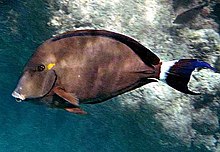| Ringtail surgeonfish | |
|---|---|

| |
| Conservation status | |
 Least Concern (IUCN 3.1) | |
| Scientific classification | |
| Domain: | Eukaryota |
| Kingdom: | Animalia |
| Phylum: | Chordata |
| Class: | Actinopterygii |
| Order: | Acanthuriformes |
| Family: | Acanthuridae |
| Genus: | Acanthurus |
| Species: | A. blochii |
| Binomial name | |
| Acanthurus blochii Valenciennes, 1835 | |
Acanthurus blochii, the ringtail surgeonfish or dark surgeonfish, is a marine ray-finned fish belonging to the family Acanthuridae, the surgeonfishes, unicornfishes and tangs. This fish is found in the Indo-Pacific.
Taxonomy
Acanthurus blochii was first formally described in 1835 by the French zoologist Achille Valenciennes with its type locality given as Mauritius. The genus Acanthurus is one of two genera in the tribe Acanthurini which is one of three tribes in the subfamily Acanthurinae which is one of two subfamilies in the family Acanthuridae.
Etymology
Acanthurus blochii honours the German physician and naturalist Marcus Elieser Bloch with its specific name. Bloch had originally described this fish as Chaetodon nigricans.
Description
Acanthurus blochii has 9 spines and 25 to 27 soft rays supporting the dorsal fin while the anal fin is supported by 3 spines and 24 or 25 soft rays. It has a relatively large spine on the caudal peduncle, the length of the spine fitting 3 to 4.4 times into the length of the head. The overall colour is blue-grey marked with a yellow spot to the rear of the eye and a white bar on the caudal fin base. There is a dark blotch surrounding the spine on the caudal peduncle. The caudal, dorsal and anal fins are dark blue to black. When seen underwater the overall colour is black broken by a lighter band on the caudal peduncle. This species has a maximum standard length of 45 cm (18 in).

Distribution and habitat
Acanthurus blochii has a wide Indo-Pacific distribution from East Africa between Djibouti and South Africa east to Hawaii, south to northern Australia and Lord Howe Island and as far north as the Ryukyu Islands of southern Japan. It is found on the outer slopes and lagoon slopes of coral reefs where it grazes algae and detritus, especially off compacted sand.
References
- ^ Choat, J.H.; Abesamis, R.; Clements, K.D.; et al. (2012). "Acanthurus blochii". IUCN Red List of Threatened Species. 2012: e.T177971A1507181. doi:10.2305/IUCN.UK.2012.RLTS.T177971A1507181.en. Retrieved 8 September 2023.
- Eschmeyer, William N.; Fricke, Ron & van der Laan, Richard (eds.). "Species in the genus Acanthurus". Catalog of Fishes. California Academy of Sciences. Retrieved 8 September 2023.
- J. S. Nelson; T. C. Grande; M. V. H. Wilson (2016). Fishes of the World (5th ed.). Wiley. pp. 497–502. ISBN 978-1-118-34233-6.
- Christopher Scharpf & Kenneth J. Lazara, eds. (12 January 2021). "Order ACANTHURIFORMES (part 2): Families EPHIPPIDAE, LEIOGNATHIDAE, SCATOPHAGIDAE, ANTIGONIIDAE, SIGANIDAE, CAPROIDAE, LUVARIDAE, ZANCLIDAE and ACANTHURIDAE". The ETYFish Project Fish Name Etymology Database. Christopher Scharpf and Kenneth J. Lazara. Retrieved 7 September 2023.
- ^ Bray, D.J. (2017). "Acanthurus blochii". Fishes of Australia. Museums Victoria. Retrieved 8 September 2023.
- Mark McGrouther (15 February 2019). "Dark Surgeon, Acanthurus blochii (Valenciennes, 1835)". Australian Museum. Retrieved 8 September 2023.
- Froese, Rainer; Pauly, Daniel (eds.). "Acanthurus blochii". FishBase. June 2023 version.
| Taxon identifiers | |
|---|---|
| Acanthurus blochii | |